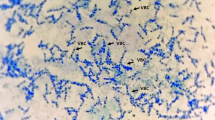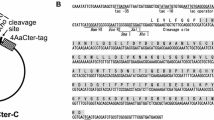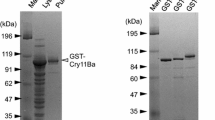Abstract
We characterized a novel Bacillus thuringiensis isolate native to Argentina (FCC 41) that exhibits a mosquitocidal activity higher than the reference B. thuringiensis subsp. israelensis. This isolate shows a rounded crystal harboring two major proteins of about 70–80 kDa. Moreover, we cloned and sequenced the encoding gene of one of the crystal proteins (Cry) consisting of an open reading frame of 2061 pb that encodes a protein of 687 amino acid residues. The deduced amino acid sequence has a predicted relative molecular mass of 78 kDa and is 52% and 45% identical to those of the reported Cry24Aa and Cry24Ba sequences, respectively. The novel Cry protein was designated as Cry24Ca, which also exhibited larvicidal activity against Aedes aegypti when its encoding gene was expressed in an Escherichia coli host strain.




Similar content being viewed by others
Literature Cited
Altschul SF, Gish W, Miller W, Myers EW, Lipman DJ (1990) Basic local alignment search tool. J Mol Biol 215:403–410
Bateman A, Birney E, Durbin R, Eddy SR, Howe KL, Sonnhammer EL (2000) The Pfam protein families database. Nucleic Acids Res 28:263–266
Ben-Dov E, Boussiba S, Zaritsky A (1995) Mosquito larvicidal activity of Escherichia coli with combinations of genes from Bacillus thuringiensis subsp. israelensis. J Bacteriol 177:2851–2857
Berón CM, Curatti L, Salerno GL (2005) A simple strategy for identification of novel cry-type genes from Bacillus thuringiensis strains. Appl Environ Microbiol 71:761–765
Berón CM, Salerno GL (2006) Characterization of Bacillus thuringiensis isolates from Argentina potentially useful in insect pest control. BioControl 51:779–794
Boonserm P, Davis P, Ellar DJ, Li J (2005) Crystal structure of the mosquito-larvicidal toxin Cry4Ba and its biological implications. J Mol Biol 348:363–382
Delécluse A, Charles JF, Klier A, Rapoport G (1991) Deletion by in vivo recombination shows that the 28-kilodalton cytolytic polypeptide from Bacillus thuringiensis subsp. israelensis is not essential for mosquitocidal activity. J Bacteriol 173:3374–3381
Delecluse A, Rosso ML, Ragni A (1995) Cloning and expression of a novel toxin gene from Bacillus thuringiensis subsp. jegathesan encoding a highly mosquitocidal protein. Appl Environ Microbiol 61:4230–4235
de Maagd RA, Bravo A, Berry C, Crickmore N, Schnepf HE (2003) Structure, diversity, and evolution of protein toxins from spore-forming entomopathogenic bacteria. Annu Rev Genet 37:409–433
Federici BA, Park HW, Bideshi DK, Wirth MC, Johnson JJ (2003) Recombinant bacteria for mosquito control. J Exp Biol 206:3877–3885
Galitsky N, Cody V, Wojtczak A, et al (2001) Structure of the insecticidal bacterial δ-endotoxin Cry3Bb1 of Bacillus thuringiensis. Acta Crystallogr D: Biol Crystallogr 57:1101–1099
Grochulski P, Masson L, Borisova S, et al (1995) Bacillus thuringiensis CryIA(a) insecticidal toxin: crystal structure and channel formation. J Mol Biol 254:447–464
Ibarra JE, del Rincon MC, Orduz S, et al (2003) Diversity of Bacillus thuringiensis strains from Latin America with insecticidal activity against different mosquito species. Appl Environ Microbiol 69:5269–5274
Ibarra JE, Federici BA (1987) An alternative bioassay employing neonate larvae for determining the toxicity of suspended particles to mosquitoes. J Am Mosq Control Assoc 3:187–192
Jeanmougin F, Thompson JD, Gouy M, Higgins DG, Gibson TJ (1998) Multiple sequence alignment with Clustal X. Trends Biochem Sci 23:403–405
Joung KB, Côte JC (2000) A review of the environmental impacts of the microbial insecticide Bacillus thuringiensis. Technical Bulletin No. 29. Horticultural Research and Development Center. Available from http://www.res2.agr.ca/stjean/crdh.html
Laemmli UK (1970) Cleavage of structural proteins during the assembly of the head of bacteriophage T4. Nature 15:680–685
Li JD, Carroll J, Ellar DJ (1991) Crystal structure of insecticidal δ -endotoxin from Bacillus thuringiensis at 2.5 A resolution. Nature 353:815–821
Liu YG, Whittier RF (1995) Thermal asymmetric interlaced PCR: automatable amplification and sequencing of insert end fragments from P1 and YAC clones for chromosome walking. Genomics 25:674–681
Mclaughlin RE, Dulmage HT, Alls R, et al (1983) U.S. standard bioassay for the potency assessment of Bacillus thuringiensis serotype H-14 against mosquito larvae. Bull Ent Soc Am 30:26–29
Morse RJ, Yamamoto T, Stroud RM (2001) Structure of Cry2Aa suggests an unexpected receptor binding epitope. Structure 9:409–417
Ohgushi A, Saitoh H, Wasano N, Uemori A, Ohba M (2005) Cloning and characterization of two novel genes, cry24B and s1orf2, from a mosquitocidal strain of Bacillus thuringiensis serovar sotto. Curr Microbiol 51:131–136
Pornwiroon W, Katzenmeier G, Panyim S, Angsuthanasombat C (2004) Aromaticity of Tyr−202 in the α4–α5 loop is essential for toxicity of the Bacillus thuringiensis Cry4A toxin. J Biochem Mol Biol 37:292–297
Rowe GE, Margaritis A (2004) Bioprocess design and economic analysis for the commercial production of environmentally friendly bioinsecticides from Bacillus thruingiensis HD-1 kurstaki. Biotechnol Bioeng 86:377–388
Sambrook J, Russell DW (2001) Molecular cloning: a laboratory manual, 3rd ed. Cold Spring Harbor Laboratory Press, Cold Spring Harbor, NY
Schnepf E, Crickmore N, Van Rie J, et al (1998) Bacillus thuringiensis and its pesticidal crystal proteins. Microbiol Mol Biol Rev 62:775–806
Servant F, Bru C, Carrère S, et al (2002) ProDom: automated clustering of homologous domains. Briefings Bioinform 3:246–251
World Health Organization (2004) World Health Report, 2004. WHO, Geneva
Acknowledgments
The authors are grateful to N. Crickmore and D. Zeigler for help with the Cry nomenclature. The authors thank Dr. Juan José García (CEPAVE, Argentina) for providing insects larvae. This investigation was supported by FIBA, CONICET and Universidad Nacional de Mar del Plata (grant 15/E142). This work is part of CMB’s PhD thesis (FCEyN, Universidad Nacional de Mar del Plata).
Author information
Authors and Affiliations
Corresponding author
Rights and permissions
About this article
Cite this article
Berón, C.M., Salerno, G.L. Cloning and Characterization of a Novel Crystal Protein from a Native Bacillus thuringiensis Isolate Highly Active Against Aedes aegypti . Curr Microbiol 54, 271–276 (2007). https://doi.org/10.1007/s00284-006-0299-8
Received:
Accepted:
Published:
Issue Date:
DOI: https://doi.org/10.1007/s00284-006-0299-8




